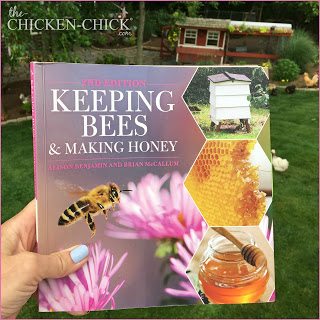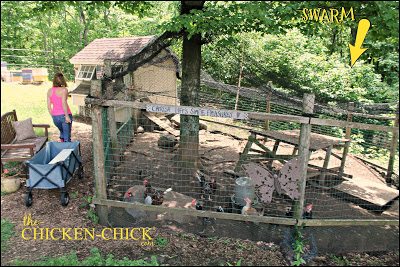I never planned to raise chickens or bees, yet here I sit, a card-carrying chicken junkie and a brand new beekeeper! I felt fairly prepared for my first flock of chickens before they arrived, but not the bees. Honey bees are such foreign creatures, I don’t know that I ever would have felt the same level of confidence going into beekeeping that I had with my first chickens. But, after Harvest Lane Honey set me up for success with all the equipment and supplies I needed to get started, any apprehension about working with bees soon disappeared as I dove head-first into a total immersion beekeeping education phase!
Backyard beekeeper kit and equipment.It was May by the time I unboxed the hive components and equipment, and I soon learned that spring is not the right time of year to source bees. Where on earth does one acquire bees, anyway? I had no idea. Come to find out, normal people begin ordering bees from local sources in the winter for delivery in spring. Oopsie.
I began my crash course in beekeeping by enrolling in an introductory beekeeping class online, visiting and consulting with several beekeepers and digging into several terrific books:
Most folks order their bees from local beekeepers in the winter for spring delivery, but not me. Luckily for me, beekeepers often catch and sell swarms. A swarm is a group of bees that leaves an existing, crowded colony with their queen to establish a new colony elsewhere. They can be found in strange places until they locate a suitable home.
Enter the lovely and talented Brenda Nye of WaggleDance Apiary. A Facebook follower of mine who lives not far from me in Connecticut and married a man I knew in high school, (#smallworld) had recently caught a swarm on the deck of her house. When she shared the swarm catch on her Instagram and Facebook pages, I contacted her about the possibility of buying some bees from her and she offered to sell me that very swarm! Timing is everything. You can watch the video of that swarm catch HERE on Brenda’s Facebook page.
Brenda held onto that bee colony for several weeks until I was able to pick them up. During that time, they settled into their new frames and busied themselves building honeycomb, raising more bees and of course, making honey.
The day I visited Brenda’s chicken yard/apiary to collect the bees, she spotted a small swarm of bees in a tree behind her chicken coop! Little did I know I would soon be helping Brenda catch that swarm!
Beekeepers use smoke as a way to keep bees calm, occupied and mask the scents (pheromones) they use to communicate with each other. When bees smell smoke they instinctively react to the possibility that there may be as a forest fire nearby; they enter honey-hoarding mode, scrambling to save their golden food stores in anticipation of a possible emergency hive evacuation. Smoke also interferes with their ability to communicate panic or danger to each other through their sense of smell, which keeps them calm while beekeepers work in the hive.
We used the smoker to inspect several of Brenda’s hives and to transfer my bees from their temporary frames to the box I would take them home in. Brenda uses her hive tool to loosen the frames away from the box. Bees make a super sticky substance known as propolis to glue things together inside a hive. It’s messy business!
Meanwhile, the swarm behind the chicken coop was hanging out in the nearby tree. When we finished with Brenda’s hives, she asked if I wanted to help catch the swarm in the tree. Apparently, swarm catching is something of a right of passage in the beekeeping world. The goal is usually to experience a swarm catch within one’s first year, not the first day! I was game and we headed to the tree with a cardboard bee transport box with a few frames in it. This is the video of our swarm-catch below. There is no big, “GOTCHA!” moment. Everything proceeds in a calm, deliberate, manner. The goal is to get the queen in the box with as many of the worker bees (females) and drones (males) as possible.
Brenda sent me home with double the number of colonies I was expecting. That sounds a lot like chicken math, doesn’t it?
Stay tuned here and on my Facebook page as my adventures in beekeeping continue!
Kathy Shea Mormino
Affectionately known internationally as The Chicken Chick®, Kathy Shea Mormino shares a fun-loving, informative style to raising backyard chickens. …Read on


shop my SPONSORS
I never planned to raise chickens or bees, yet here I sit, a card-carrying chicken junkie and a brand new beekeeper! I felt fairly prepared for my first flock of chickens before they arrived, but not the bees. Honey bees are such foreign creatures, I don’t know that I ever would have felt the same level of confidence going into beekeeping that I had with my first chickens. But, after Harvest Lane Honey set me up for success with all the equipment and supplies I needed to get started, any apprehension about working with bees soon disappeared as I dove head-first into a total immersion beekeeping education phase!
Backyard beekeeper kit and equipment.It was May by the time I unboxed the hive components and equipment, and I soon learned that spring is not the right time of year to source bees. Where on earth does one acquire bees, anyway? I had no idea. Come to find out, normal people begin ordering bees from local sources in the winter for delivery in spring. Oopsie.
I began my crash course in beekeeping by enrolling in an introductory beekeeping class online, visiting and consulting with several beekeepers and digging into several terrific books:
Most folks order their bees from local beekeepers in the winter for spring delivery, but not me. Luckily for me, beekeepers often catch and sell swarms. A swarm is a group of bees that leaves an existing, crowded colony with their queen to establish a new colony elsewhere. They can be found in strange places until they locate a suitable home.
Enter the lovely and talented Brenda Nye of WaggleDance Apiary. A Facebook follower of mine who lives not far from me in Connecticut and married a man I knew in high school, (#smallworld) had recently caught a swarm on the deck of her house. When she shared the swarm catch on her Instagram and Facebook pages, I contacted her about the possibility of buying some bees from her and she offered to sell me that very swarm! Timing is everything. You can watch the video of that swarm catch HERE on Brenda’s Facebook page.
Brenda held onto that bee colony for several weeks until I was able to pick them up. During that time, they settled into their new frames and busied themselves building honeycomb, raising more bees and of course, making honey.
The day I visited Brenda’s chicken yard/apiary to collect the bees, she spotted a small swarm of bees in a tree behind her chicken coop! Little did I know I would soon be helping Brenda catch that swarm!
Beekeepers use smoke as a way to keep bees calm, occupied and mask the scents (pheromones) they use to communicate with each other. When bees smell smoke they instinctively react to the possibility that there may be as a forest fire nearby; they enter honey-hoarding mode, scrambling to save their golden food stores in anticipation of a possible emergency hive evacuation. Smoke also interferes with their ability to communicate panic or danger to each other through their sense of smell, which keeps them calm while beekeepers work in the hive.
We used the smoker to inspect several of Brenda’s hives and to transfer my bees from their temporary frames to the box I would take them home in. Brenda uses her hive tool to loosen the frames away from the box. Bees make a super sticky substance known as propolis to glue things together inside a hive. It’s messy business!
Meanwhile, the swarm behind the chicken coop was hanging out in the nearby tree. When we finished with Brenda’s hives, she asked if I wanted to help catch the swarm in the tree. Apparently, swarm catching is something of a right of passage in the beekeeping world. The goal is usually to experience a swarm catch within one’s first year, not the first day! I was game and we headed to the tree with a cardboard bee transport box with a few frames in it. This is the video of our swarm-catch below. There is no big, “GOTCHA!” moment. Everything proceeds in a calm, deliberate, manner. The goal is to get the queen in the box with as many of the worker bees (females) and drones (males) as possible.
Brenda sent me home with double the number of colonies I was expecting. That sounds a lot like chicken math, doesn’t it?
Stay tuned here and on my Facebook page as my adventures in beekeeping continue!











































I am SOOOOO serious about wanting to do this! Having homegrown honey could help with seasonal allergies in my family! Having more “girls” to love (beside our layers) would be wonderful! And having them help pollinate my gardens…! Not to mention delishiouness! I am also very interested in the healing properties of honey. Nothing but good!
Nice to have you here, Leslie!
Thank you for the opportunity and everything you do. Just joined the page today!
Gathering info to make an informed decision about beekeeping. Just want to make sure I’m truly commited before taking the plunge.
I have 2 hives that I just started in April. Would just love the book…it is a constant learning process and I am excited with the whole process of beekeeping.